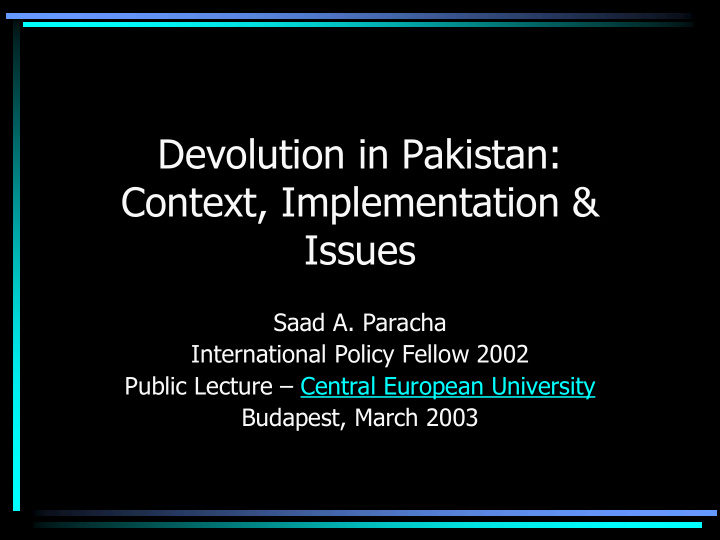



Devolution in Pakistan: Context, Implementation & Issues Saad A. Paracha International Policy Fellow 2002 Public Lecture – Central European University Budapest, March 2003
Outline of Presentation • Project timing & objectives • Country information • Contextualizing the devolution plan • Political structures & systems • Administrative structures & systems • Fiscal and development structures • Conclusions & recommendations
Project Timing & Objectives • Timing – LG elections, initial days of local govt. • Objectives – Study the overall devolution program in terms of its content and implementation – To suggest corrective policy recommendations for improving the program
Country Information Area 796,096 sq. Km. Population 145 million (2000 est.). Main cities Islamabad, Rawalpindi, Karachi, Lahore, Peshawar, Quetta. Climate winter months from October to march. Currency 1 Rupee = 100 Paisas. Exchange rate US$ 1 = Pak Rs. 58.0. Fiscal year July 1 – June 30. Time five hours ahead of GMT. Religion Muslim (97%) Christian, Hindu. Type of govt. Federation, bicameral legislature. Provinces Balochistan, North West Frontier Province Punjab, Sindh, Islamabad, federally administered areas.
Context • Local governments in Pakistan – Not recognized by constitution as third tier – Uneven development (military & civilian times) – Every renewal a new experiment without backward-forward linkages – Poor coexistence of LGs with political govts – Bureaucratic and provincial controls – Weak resource base and implementation capacity – Poor participation of people
The Devolution Plan 2000
Devolution Plan 2000 (Cont.) The Basic Structure
Devolution • the transfer of resources and power (and often, tasks) to lower-level authorities which are largely or wholly independent of higher levels of government, and which are democratic in some way and to some degree (Manor, 1997) • Principle of subsidiarity The local authorities will have the authority and responsibility to address all problems that are, in their determination, within their ability to solve
Why Devolve? • Improves governance and public service delivery by increasing: – Allocative efficiency — through better matching of public services to local preferences. – Productive efficiency — through increased accountability of local governments to citizens, fewer levels of bureaucracy, and better knowledge of local costs. (Azfar, 1999)
Political Structures & Systems • District (Indirectly elected) – Nazim, Naib Nazim, Council • Tehsil/Town/Taluqa (Indirectly elected) – Nazim, Naib Nazim, Council • Union (Directly elected) – Nazim, Naib Nazim, Council – General 12, workers/peasants 6, minority 1, Nazim and Naib Nazim • All elections to LGs on non-party basis, whereas those to higher levels on party basis
Political Structures & Systems (cont.) Principal Observations • Social setup & expectation from new roles • Enthusiastic reception-representation, fresh blood, new faces • Women, marginalized groups minus minorities • Capacity issues • Role / Responsibility ambiguities • Constraints to work- TA/DA, stipend • Qualification disjoint (Matriculation vs. BA) • Emerging issues-Relationships between districts and other elected bodies - development funds
Administrative Structures & Systems • District Administration headed by District Coordination Office • Tehsil Municipal Administration headed by Tehsil Municipal Officer • Union Administration headed by Nazim and assisted by 3 Secretaries
Administrative Structure in District
Admin. Structures & Systems (cont.) Principal Observations • First time subservience & bureaucratic frustration • Personnel issues (recruitment, posting, transfer) • New departments • Capacity issues • Failure to achieve smooth transition of new DCO (unresolved statutes/laws)
Financial & Development Structures • Provincial Finance Commissions • Tax assignments • Citizen Community Boards – Purpose, constitution, working • Monitoring Committees
Fin. & Dev. Structures (cont.) Principal Observations • Delay in establishment of accounting/audit structures and posting of finance office staff • Dependency on Federal/Provincial transfers • Delayed announcement of PFCs • Budget formulation still being done by provinces • Duplication of tax authority (province/districts) • New taxes not buoyant • Expenditure restrictions on districts • Composition of budgets (current more than 90%) • CCBs and monitoring committees-the silence and its effect (non utilization of reserved portion of development budget-50%)
Conclusions • One formula fits all, implementation in one go • Devolution – phases (from center to province and from province to districts) • Failure to undertake financial repercussions-the transition committees never submitted their reports • Increased political participation yes, sustainability & effectivity in doubt • Unfinished agenda- unestablished bodies, departments, failure to make changes in the ordinance due to rigidity • New agenda- Provincial & National Assembly Elections and emerging conflicts – Party or non-party based elections – to have or have not • Constitutional protection without endorsement of parliament- LFO
Policy Recommendations • Continuity • Political – Independence for provinces to manage local govt. through constitution of a high powered body from LGs – Ending uncertainty on constitutional position of LGs – Holding of next elections in one go for each province – Capacity building of political representatives with opportunities to play a role – Special focus on women councilors for enabling them to play a meaningful role – Mechanisms for creating symbiotic relationship between LGs and other political tiers – Education qualification may be relaxed for a person elected twice to LGs for competing for higher political levels
Policy Recommend. (Cont.) • Administrative – Regrouping of new departments – Functionalizing Local Government Commissions – Starting capacity building programs as a continuos process – Removing bar from LGs on recruitment – Clarifying the role and powers of DCO – Creation of a provincial local government cadre • Financial & developmental – Steps for energizing CCBs (funding, in kind) – Speeding up establishment of audit/account structures – More expenditure authority to LGs – Activating monitoring committees after regrouping
Recommend
More recommend